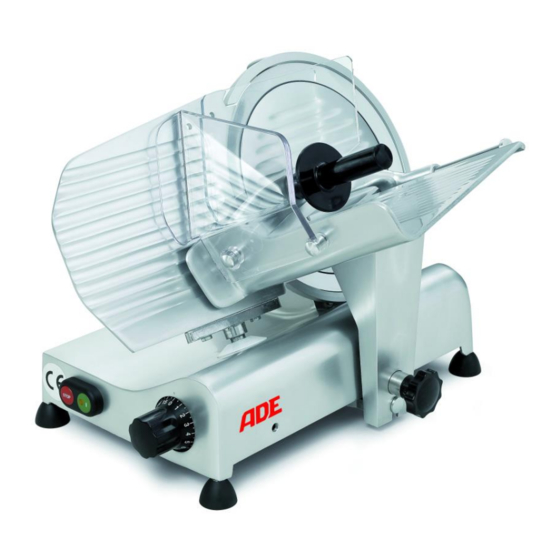
Summary of Contents for ADE HANSE Series
- Page 1 Series HANSE Hanse-180522-Rev007-UM-en IMPORTANT FOLLOW THE USER GUIDE PLEASE KEEP FOR FUTURE REFERENCE...
-
Page 2: Table Of Contents
CONTENTS PREFACE ..............................2 Introduction ............................... 2 Usage ............................... 2 COMISSIONING............................3 Opening the package ..........................3 Installation ..............................3 Electrical supply............................3 Operation ..............................4 OPERATING FUNCTIONS AND SAFETY REQUIREMENTS ..............4 Operating Functions ..........................4 Mechanical Safety Devices ........................4 Acceptance test ............................ -
Page 3: Preface
These machines may only be used in their original condition or when equiped with original spare parts. The safety devices may not be removed. A machine must immediately be taken out of operation in the event of one of its safety devices being damaged and ADE then informed of the replacement and/or spare part re- quirement. -
Page 4: Comissioning
COMISSIONING Ensure that on receipt of the package containing the meat slicing machine there is no sign of any damage having occurred during transport. 2.1 Opening the package • Open the carton and remove the machine. • Inspect the contents of the package and that they correspond with those listed on the delivery note. Packaging materials are potentially recyclable and may not be disposed of in the normal household rubbish. -
Page 5: Operation
2.4 Operation This meat slicing machine is only to be used for its intended purpose. Under no circumstances may the oper- ator hold the product to be cut in their hand. Instead, it must be secured using the handling carriage holder. Hands are to be kept away from the cutting blade at all times. -
Page 6: Using The Meat Slicing Machine
USING THE MEAT SLICING MACHINE 4.1 Operating procedure 1) Set the graduated rotating knob "A" to "0" (null). 2) Pull the handling carriage using the carriage arm "B" as far as possible towards the operator. 3) Lift the holder "C" using grip "D", which is intended for this purpose. Ensure that the machine is switched off before laying the product to be cut on the carriage and lowering the holder onto or behind the product. -
Page 7: Servicing And Maintenance Of The Meat Slicing Machine
SERVICING AND MAINTENANCE OF THE MEAT SLICING MACHINE For hygienic reasons meat slicing machines must be kept clean at all times. They must be disassembled and cleaned both at the end of each working day and each time the type of product being cut is changed (e.g. from fresh to cooked meat). -
Page 8: Blade Sharpening Procedure
BLADE SHARPENING PROCEDURE The cutting blade must always be kept well sharpened in order to ensure problem-free operation of the ma- chine. It should be noted that regular 'short' sharpening is to be preferred over more extensive operations. Always ensure that before starting with this type of operation, the graduated knob for adjusting the cut thick- ness has been set to "0". -
Page 9: Training
Only products with a Ph of 7-8 may be used for cleaning. WARRANTY ADE will repair or replace this product within a period of 2 year from date of delivery applying to defects oc- curred due to poor material or workmanship (invoice is necessary). -
Page 10: Technical Data
− Low Voltage Directive 2014/35/EU − RoHS Directive 2011/65/EG in the currently valid versions. This declaration loses its validity if modifications are made to the machine without our approval. Hamburg, May 2018 ADE GmbH & Co. Hammer Steindamm 27 – 29 D-22089 Hamburg... -
Page 11: Circuit Diagrams
12. CIRCUIT DIAGRAMS HANSE 250 / 300 - 230V / 50 Hz Block circuit diagram HANSE 250 300 - 230V / 50 Hz Circuit diagram LIVE WIRE NEUTRAL WIRE SWITCHING RELAY CONTACT SWITCHING RELAY THERMAL RELAY CONTACT THERMAL RELAY LED SWITCH MOTOR Pm ON SWITCH OFF SWITCH... - Page 12 HANSE 250 / 300 – 230V / 60 Hz Block circuit diagram HANSE 250 / 300 - 230V / 60 Hz Circuit diagram LIVE WIRE NEUTRAL WIRE SWITCHING RELAY CONTACT SWITCHING RELAY THERMAL RELAY CONTACT THERMAL RELAY LED SWITCH MOTOR Pm ON SWITCH OFF SWITCH CAPACITOR...
-
Page 13: Exploded View
HANSE 300-400V 50/60 Hz Circuit diagram BLUE \ ERO BLUE BLACK Transformation 220V 3 ph. / 380V 3 ph. STOP R1= RELAY TR= TRANSFORMER START SL= LIGHT SIGNAL OFF BUTTON ON BUTTON MOTOR Sr* OUTPUT CONTACT 13. EXPLODED VIEW HANSE 250-230V... - Page 14 HANSE 300-230V HANSE 300-400V...
-
Page 15: Spare Parts List
14. SPARE PARTS LIST HANSE 250-230 V Hanse 250 DESCRIPTION QTY. PART NO. Cutting thickness adjuster H4090-011 Suction foot H4090-005 Circular blade, smooth H4090-011 Circular blade, smooth, Teflon coated H4090-0141 Circular blade, toothed H4090-021 Circular blade, toothed, Teflon coated H4090-0211 Carriage rear wall H4090-001 Grease remover... - Page 16 HANSE 300-230 V Hanse 250 DESCRIPTION QTY. PART NO. Circular blade, smooth H4090-019 Circular blade, smooth, Teflon coated H4090-0191 Circular blade, toothed H4090-022 Circular blade, toothed, Teflon coated H4090-0221 Carriage rear wall H4090-001 Switch H4090-053 Relay H4090-066 Blade cover plate H4090-025 Protective plate for holder H4090-032...
- Page 17 HANSE 300-400 V Hanse 250 DESCRIPTION QTY. PART NO. Circular blade, smooth H4090-019 Circular blade, smooth, Teflon coated H4090-0191 Circular blade, toothed H4090-022 Circular blade, toothed, Teflon coated H4090-0221 Carriage rear wall H4090-001 9683 Switch with relais Relay H4090-066 Blade cover plate H4090-025 Protective plate for holder H4090-032...
- Page 20 Supplier:...















Need help?
Do you have a question about the HANSE Series and is the answer not in the manual?
Questions and answers